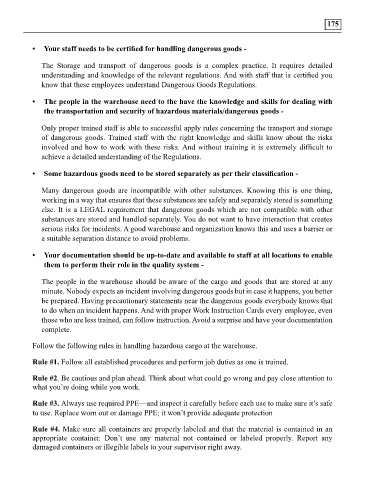Page 175 - Warehouse 1 to 9
P. 175
174 175
• SECTION 13: Disposal considerations • Your staff needs to be certified for handling dangerous goods -
o 13.1. Waste treatment methods The Storage and transport of dangerous goods is a complex practice. It requires detailed
understanding and knowledge of the relevant regulations. And with staff that is certified you
• SECTION 14: Transport information know that these employees understand Dangerous Goods Regulations.
o 14.1. UN number • The people in the warehouse need to the have the knowledge and skills for dealing with
the transportation and security of hazardous materials/dangerous goods -
o 14.2. UN proper shipping name
Only proper trained staff is able to successful apply rules concerning the transport and storage
o 14.3. Transport hazard class(es)
of dangerous goods. Trained staff with the right knowledge and skills know about the risks
o 14.4. Packing group involved and how to work with these risks. And without training it is extremely difficult to
achieve a detailed understanding of the Regulations.
o 14.5. Environmental hazards
• Some hazardous goods need to be stored separately as per their classification -
o 14.6. Special precautions for user
Many dangerous goods are incompatible with other substances. Knowing this is one thing,
o 14.7. Transport in bulk according to Annex II of MARPOL73/78 and the IBC Code working in a way that ensures that these substances are safely and separately stored is something
else. It is a LEGAL requirement that dangerous goods which are not compatible with other
• SECTION 15: Regulatory information substances are stored and handled separately. You do not want to have interaction that creates
o 15.1. Safety, health and environmental regulations/legislation specific for the substance or serious risks for incidents. A good warehouse and organization knows this and uses a barrier or
mixture a suitable separation distance to avoid problems.
o 15.2. Chemical safety assessment • Your documentation should be up-to-date and available to staff at all locations to enable
them to perform their role in the quality system -
• SECTION 16: Other information
The people in the warehouse should be aware of the cargo and goods that are stored at any
o 16.2. Date of the latest revision of the SDS minute. Nobody expects an incident involving dangerous goods but in case it happens, you better
be prepared. Having precautionary statements near the dangerous goods everybody knows that
9.4 The safety rules and procedures to be followed in a warehouse Hazardous Cargo: to do when an incident happens. And with proper Work Instruction Cards every employee, even
Hazardous material is one which is capable of producing effects like fire, explosion, sudden those who are less trained, can follow instruction. Avoid a surprise and have your documentation
release of pressure and may cause acute health effects like burns, injuries, convulsions or even complete.
organ damage. In spite of several challenges Hazardous material is required in various stages of Follow the following rules in handling hazardous cargo at the warehouse.
manufacturing and need to be stored in a warehouse.
Rule #1. Follow all established procedures and perform job duties as one is trained.
Following are some of the suggestions for handling hazardous material in the warehouse:
Rule #2. Be cautious and plan ahead. Think about what could go wrong and pay close attention to
• Have the right procedures and that works according to the current regulations - what you’re doing while you work.
Procedures are made to ensure your company requirements are met in your warehouse. Your Rule #3. Always use required PPE—and inspect it carefully before each use to make sure it’s safe
requirements for safety, to prevent cargo damage, to ensure correct and punctual delivery of to use. Replace worn out or damage PPE; it won’t provide adequate protection
goods from your warehouse. Meeting all of these requirements is what makes procedures right.
Make sure your warehouse is operating the right procedures for your cargo and your organisation Rule #4. Make sure all containers are properly labeled and that the material is contained in an
requirements. appropriate container. Don’t use any material not contained or labeled properly. Report any
damaged containers or illegible labels to your supervisor right away.

